-- From Chiang Khong to Chiang Rai
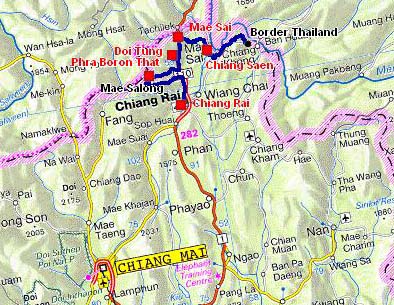
The road tracklog
from Chiang Khong to Chiang Rai
from 18/02 to 22/02/2009
The 18/02 in Huay Xai
in Laos I embarked on the vehicle ferry around 09:40 to land in
Thailand about 10:12. I was dealt with by a customs officer who led me to the
office then took along me by motorbike to the Customs headquarters in Chiang
Khong where a “Simplified Customs Declaration Form” was found on the computer
from a photocopy of the preceding entry that I had given. We went again to the
port to record the document on the handrail then I went to immigration to
receive a only fifteen day free VOA since the last military putsch.
During the handing-over of the Carnet de Passage en Douane at customs in Huay
Xai I realized with amazement that the new CPD which I received from the ACF
in Vientiane had an erroneous validity date. I was to announce it to the ACF
to send to me a correct CPD in urgency in Chiang Mai.
With my truck I entered Chiang Khong to update my website not without difficulties. I had
lunch on the spot before heading towards Chiang Saen where I wished to bivouac.
On the move I stopped in Wat Pra Dhat Pha-Ngao where a teakwood carving Ubosatha
Hall as well as a Chedi were dominating the Mekong River on a hill.
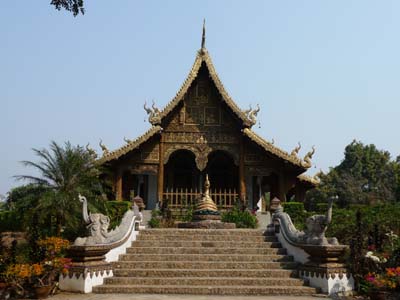
Teakwood Carving Ubosatha Hall
Wat Pra Dhat Pha-Ngao
18/02/2009
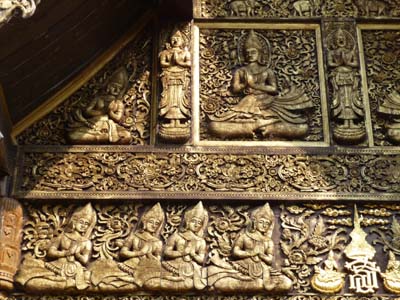
Teakwood Carving Ubosatha Hall
Wat Pra Dhat Pha-Ngao
18/02/2009
Chiang Saen does not worth a detour, except a Chedi, stupa, of Lanna style which would date between 12th and the 14th century.
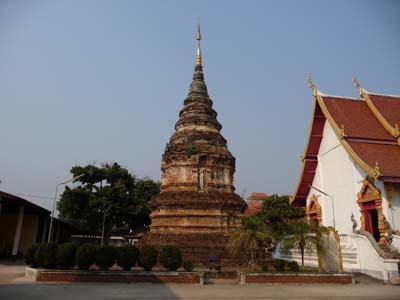
Wat Pha-Khao Pan
Chiang Saen
18/02/2009
The first visit of 19/02 was a few kilometres away from Mae Saen at the confluence of Nam Ruak and Mekong called the Golden Triangle, Sop Ruak, where poppy was cultivated. At the edge of Mekong a huge brass Buddha turned towards the downstream of the river give his benefits with the local tourists. But for foreigners main attraction is a very didactic opium museum explaining not only the Mediterranean origin of poppy but also its use.
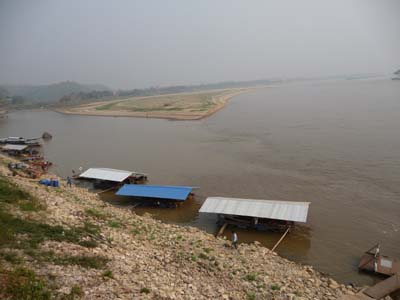
Confluence of Nam Ruak andu Mekong River
Sop Ruak
19/02/2009
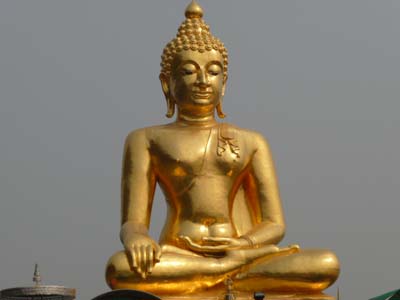
Giant Buddha
Sop Ruak
19/02/2009
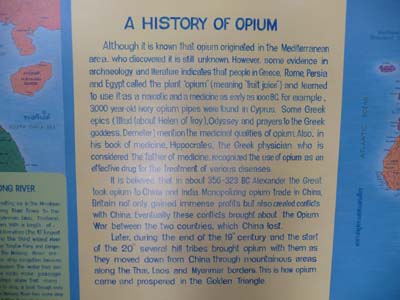
House of opium
Sop Ruak
19/02/2009
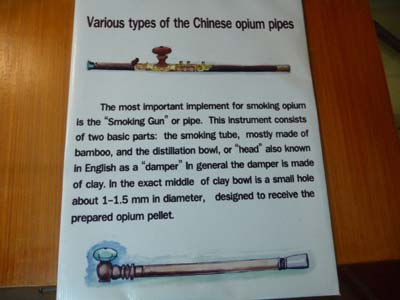
House of opium
Sop Ruak
19/02/2009
Still a few kilometres in mountain the frontier town of Mae Sai, the most septentrional of Thailand, offers to visitors the products of Burma, Myanmar, localized on other bank of Mae Nam Sai as of Laos on the main street leading to the border post. Dominating the city and Burma Wat That Doi Wao dates back to 1965.
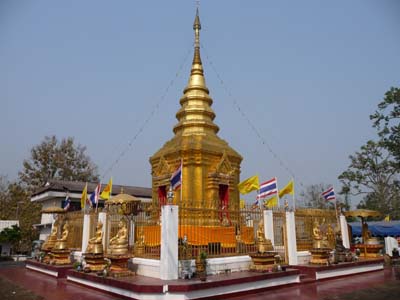
Wat Phra That Doi Wan
Mae Sai
19/02/2009
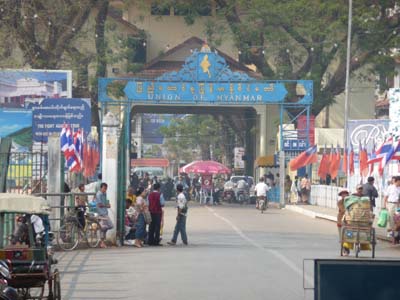
Union of Muanmar
Mae Sai
19/02/2009
The 20/02 I left Mae Sai to visit Doi Tung in the mountain at the border of Myanmar where a chalet and botanical gardens of the late Queen Mother are. I desired to take the road 1149 at the exit of Mae Sai but five kilometres further I was stopped at a police barrier of which the officer asked me to go back the road being too sloping! Halfway between Mae Sai and Mae Chan I took the other end of the road 1149. At the carpark of Doi Tung I was again stopped by a police car whose driver squirted vehicle vociferating to make me park further. Official of the site explained me calmly that a member of the royal family arrived; nobody was not to be visible. I had already attended this spectacle of another age at the time of my visit in Khao Yai NP. By safety or not to pollute the sight of the royal person people were hidden! Moreover only gardens were accessible. It was a kaleidoscope of colours and fragrances of shrubs and plants in blooms. Alas technique still does not make it possible to store odours. In the early afternoon I establish my bivouac on a platform in front of a valley where vehicles of forest fire control were.
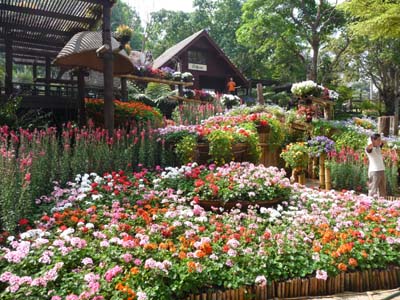
Mae Fah Luang Gardens
Doi Tung
20/02/2009
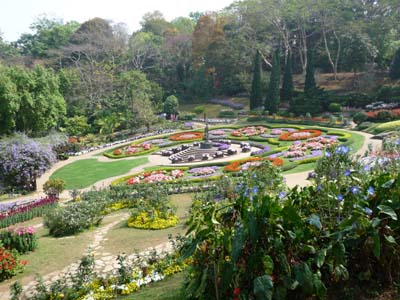
Mae Fah Luang Gardens
Doi Tung
20/02/2009
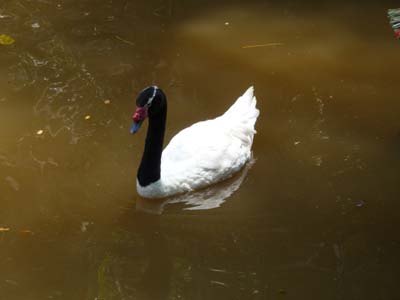
Mae Fah Luang Gardens
Doi Tung
20/02/2009
The purpose of the 21/02 consisted in heading to visit Mae Salong the retreat of Kuomintang after its escape from China into 1949 towards Burma which was an effective partner of the warlord Khun Sa and of Shan United Army for the recognition of a Independent Shan State in Burma as a opium trafficker of the Golden Triangle. After 1980’s the policy of the Thai government of poppy eradication bore its fruits by replacing it by the culture of the tea-tree, plant coming from Taiwan, coffee-tree and the fruit-trees. The single street of Mae Salong is a succession of shops with Chinese signs, sale of tea and dry fruits adapted to all sauces. Only the road 1130 heading to Mae Salong was worthy of interest. It winds from croups to hollow in dramatic landscapes in fog morning.
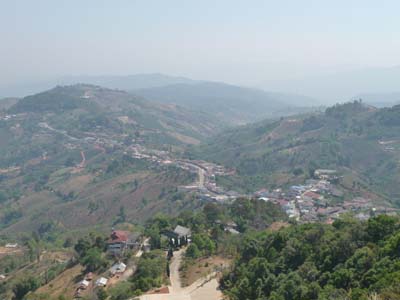
Bird's eye view
Mae Salong
21/02/2009
In the village Stupa and 7/Eleven, paramount of Thailand’s sights, marked the landscape.
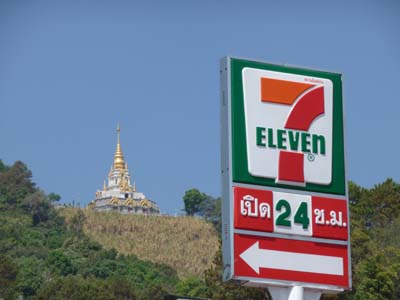
Paramount of Thailand's sights
Mae Salong
21/02/2009
This border area of Burma is populated with various ethnic minorities.
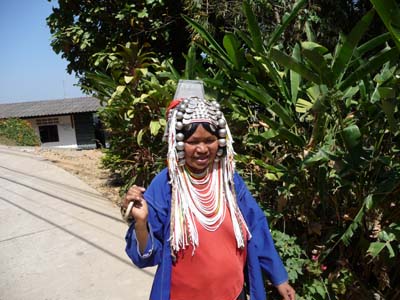
Ethnic minority
Mae Salong
21/02/2009
I bivouacked at the bottom of Phra Boron That at 1300 metres of altitude overlooking the valley.
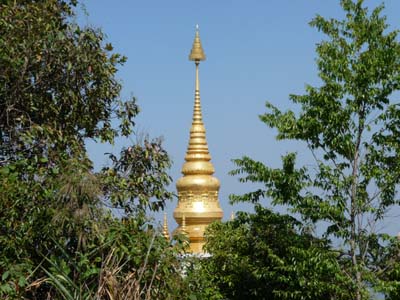
Phra Boron That
Mae Salong
21/02/2009
The 22/02 before leaving Mae Salong I paid a visit to the Memorial of Kuomintang at the southern exit of the town. It is composed of three buildings of which the central part is a Chinese temple, the left side wing presents some photographs of the epopee of the 93rd regiment from Kumning to Burma, alas there are labelled in Thai and in Chinese, the right side wing exhibits some photographs of the reconversion of the community to agriculture of the tea and to breeding, of course it is not question of the poppy cultivation.
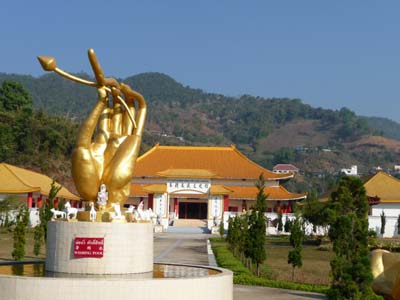
Memorial of Kuomintang
Mae Salong
22/02/2009
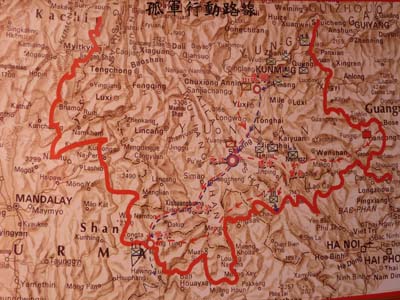
Memorial of Kuomintang
Mae Salong
22/02/2009
I arrived in the late morning in Chiang Rai to go to Internet and laundry. Then after having lunch I walked in the city which I had visited in January 2008. I bivouacked at the edge of the Mae Nam Kok.
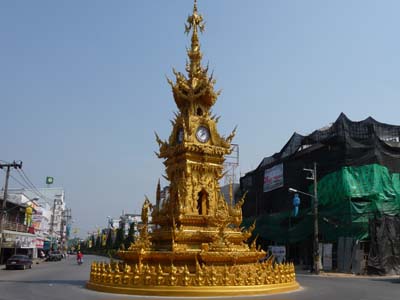
Clock tower
Chiang Rai
22/02/2009
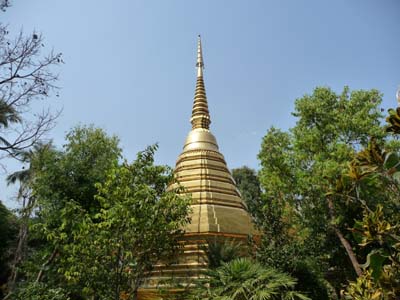
Chedi of Wat Phra Kaew
Chiang Rai
22/02/2009
The next week I will make an escape in the province of Nan in the east while waiting for the arrival of a Carnet de Passage en Douane with correct dates delivered by DHL in Chiang Mai.